The ultimate camera tech?
Kia ora tatou:
As the man said, it’s a hard road finding the perfect camera tech, son, especially when you need to get your sensor cleaned. But there is a solution at hand, especially if you live in Christchurch.
I have heard a lot of horror stories about sensor cleaning. People using tissues, spit, blower brushes (and using the brush bit). Well, in a word, don’t.
If you own a digital SLR, your sensor will need to be cleaned at some point- with one exception, the Olympus SLRs, which have an inbuilt ultrasonic cleaning device. The rest of us will need to do at some point. You can minimise dust build-up by switching the camera off when changing lenses, which discharges the sensor, and doing so with your back to the wind.
So how do you know when it is time to clean the sensor? Large areas of clear blue sky are classic areas where it is obvious. Enlarge your file to 100% and scroll around, looking for those telltale areas of blobby tone. There is a better way. Go outside; shoot an area of clear blue sky with the focus at infinity. Then open it and apply auto levels. Hey presto! (It’s not a bad way of seeing dead pixels either, and a good way of checking the sensor on that second-hand SLR you may be thinking of buying.)
If you are going to do it yourself, then a few guidelines are in order.
Use a proprietary sensor-cleaning device, such as a SensorBrush (available on the Net). You can read about them here. Do not use any old brush.
Before you begin, RTFM (read the friendly manual). Most digital SLRs have a special setting for cleaning. I am told that Nikons need a special accessory power adaptor. Nikonnnies help me out here. This opens the shutter and locks the mirror up. If you must use your battery pack, make sure it is fully-charged.
DO NOT USE ‘B’ or ‘T’. This is not the same thing. The sensor-cleaning setting desensitises the sensor and discharges it. Using B/T has been known to cause scarring on the sensor.
If this scares you, then don’t go there. I know I would rather have an expert in there, for the same reason I take my truck to a mechanic to be serviced. They know what they are doing. There is a reason why they spent 3 years learning to do it. So what is the answer?
Take your camera to a competent technician. And, curiously enough, I happen to know of one I highly recommend.
Enter Hayden Marshall. He used to be a camera technician for H.E Perry, the Olympus/Bronica/Bowens/ Ilford agents. Now he works in Papanui from his home.
And does he know his stuff! He showed me the ex-20D he has restored to fully functional, and the Canon FD (that’s manual focus) lenses he has converted to run in an EOS AF mount. He did this by turning custom mounts on a lathe and then mounting them on the base of the lens.
He has been servicing my gear for the last 6 months or so. He picked up a nasty little fault in my 24-70/2.8L, which would have made life difficult indeed. The focus was a little stiff and the lens barrel was catching a little. He spotted it, found the screws that had dropped into the guts of the lens, repaired, cleaned and reassembled the lens for a really reasonable price. That’s what I call service!
He does manual and AF cameras, studio flash, you name it. And he is really reasonable.
And he is a secret I am happy to spill. You can phone him on +64 3 352 6737 or +64 21 264 0633. You can even email him
Ka kite ano


0 Comments:
Post a Comment
<< Home